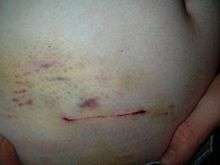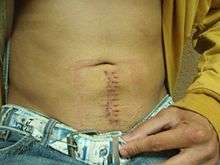Appendectomy
| Appendectomy | |
|---|---|
| Intervention | |
 An appendectomy in progress | |
| ICD-10-PCS | 0DTJ?ZZ |
| ICD-9-CM | 47.0 |
| MeSH | D001062 |
| MedlinePlus | 002921 |
An appendectomy (sometimes called appendisectomy or appendicectomy) is the surgical removal of the vermiform appendix. This procedure is normally performed as an emergency procedure, when the patient is suffering from acute appendicitis. However, a 12-hour delay had no effect on outcomes, in a large retrospective study.[1]
In one large observational study in 2003, 30-day mortality was 1.8% in an adult population.[2]
Appendectomy may be performed laparoscopically (in minimally invasive surgery) or as an open operation. Laparoscopy is often used if the diagnosis is in doubt, or if it is desirable to hide the scars in the umbilicus or in the pubic hair line. Recovery may be a little quicker with laparoscopic surgery; the procedure is more expensive and resource-intensive than open surgery and generally takes a little longer, with the (low in most patients) additional risks associated with pneumoperitoneum (inflating the abdomen with gas). Advanced pelvic sepsis occasionally requires a lower midline laparotomy.
Procedure

In general terms, the procedure for an open appendectomy is:
- Antibiotics are given immediately if signs of sepsis are seen; otherwise, a single dose of prophylactic intravenous antibiotics is given immediately before surgery.
- General anaesthesia is induced, with endotracheal intubation and full muscle relaxation, and the patient is positioned supine.
- The abdomen is prepared and draped and is examined under anesthesia.
- If a mass is present, the incision is made over the mass; otherwise, the incision is made over McBurney's point, one-third of the way from the anterior superior iliac spine to the umbilicus; this represents the position of the base of the appendix (the position of the tip is variable).
- The various layers of the abdominal wall are opened.
- The effort is always made to preserve the integrity of abdominal wall. Therefore, the external oblique aponeurosis is split along the line of its fibers, as is the internal oblique muscle. As the two run at right angles to each other, this reduces the risk of later incisional hernia.
- On entering the peritoneum, the appendix is identified, mobilized, and then ligated and divided at its base.
- Some surgeons choose to bury the stump of the appendix by inverting it so it points into the caecum.
- Each layer of the abdominal wall is then closed in turn.
- The skin may be closed with staples or stitches.
- The wound is dressed.
- The patient is brought to the recovery room.
Incisions
These incisions are placed for appendectomy: 1) McBurney's incision, also known as grid iron incision 2) Lanz incision 3) Rutherford morrision 4) Paramedian incision
Over the past decade, the outcomes of laparoscopic appendectomies have compared favorably to those for open appendectomies because of decreased pain, fewer postoperative complications, shorter hospitalization, earlier mobilization, earlier return to work, and better cosmesis. However, despite these advantages, efforts are still being made to decrease abdominal incision and visible scars after laparoscopy. Recent research has led to the development of natural orifice transluminal endoscopic surgery (NOTES).[3] However, numerous difficulties need to be overcome before a wider clinical application of NOTES is adopted, including complications such as the opening of hollow viscera, failed sutures, a lack of fully developed instrumentation, and the necessity of reliable cost-benefit analyses.[3]
Many surgeons have attempted to reduce incisional morbidity and improve cosmetic outcomes in laparoscopic appendicectomy by using fewer and smaller ports. Kollmar et al. described moving laparoscopic incisions to hide them in the natural camouflages like the suprapubic hairline to improve cosmesis. Additionally, reports in the literature indicate that minilaparoscopic appendectomy using 2– or 3-mm or even smaller instruments along with one 12-mm port minimizes pain and improves cosmesis. More recently, studies by Ates et al. and Roberts et al. have described variants of an intracorporeal sling-based single-port laparoscopic appendectomy with good clinical results.[3]
Also, a trend is increasing towards single-incision laparoscopic surgery (SILS), using a special multiport umbilical trocar. With SILS, a more conventional view of the field of surgery is seen compared to NOTES. The equipment used for SILS is familiar to surgeons already doing laparoscopic surgery. Most importantly, it is easy to convert SILS to conventional laparoscopy by adding a few trocars; this conversion to conventional laparoscopy is called 'port rescue'. SILS has been shown to be feasible, reasonably safe, and cosmetically advantageous, compared to standard laparoscopy.[3] However, this newer technique involves specialized instruments and is more difficult to learn because of a loss of triangulation, clashing of instruments, crossing of instruments (cross triangulation), and a lack of maneuverability. Also, the additional problem of decreased exposure and the added financial burden of procuring special articulating or curved coaxial instruments exist. SILS is still evolving, being used successfully in many centres, but with some way to go before it becomes mainstream. This limits its widespread use, especially in rural or peripheral centres with limited resources.[3]
Pregnancy
If appendicitis develops in a pregnant woman, an appendectomy is usually performed and should not harm the fetus.[4] The risk of premature delivery is ~10% [5] The risk of fetal death in the perioperative period after an appendectomy for early acute appendicitis is 3 to 5%. The risk of fetal death is 20% in perforated appendicitis.[6]
Recovery


A study from 2010 found that the average hospital stay for patients with appendicitis in the United States was 1.8 days. For patients with a perforated (ruptured) appendix, the average length of stay was 5.2 days.[7]
Recovery time from the operation varies from person to person. Some take up to three weeks before being completely active; for others, it can be a matter of days. In the case of a laparoscopic operation, the patient has three stapled scars of about an inch (2.5 cm) in length, between the navel and pubic hair line. When an open appendectomy has been performed, the patient has a 2–3-inch (5–7.5 cm) scar, which will initially be heavily bruised.[8]
Epidemiology
About 327,000 appendectomies were performed during U.S. hospital stays in 2011, a rate of 10.5 procedures per 10,000 population. Appendectomies accounted for 2.1% of all operating-room procedures in 2011.[9]
History
The first recorded successful appendectomy was on December 6, 1735 at St. George’s Hospital in London, when French surgeon Claudius Amyand described the presence of a perforated appendix within the hernial sac of an 11-year-old boy who had undergone successful herniotomy. The organ had apparently been perforated by a pin the boy had swallowed. The patient, Hanvil Andersen, made a spectacular recovery and was discharged a month later.[10]
In 1889 in New York City, Charles McBurney described the presentation and pathogenesis of appendicitis accurately and developed the teaching that an early appendectomy was the best treatment to avoid perforation and peritonitis.
Some cases of autoappendectomies have occurred. One was attempted by Evan O'Neill Kane in 1921, but the operation was completed by his assistants. Another was Leonid Rogozov, who had to perform the operation on himself as he was the only doctor on a remote Antarctic base.[11][12]
On September 13, 1980 Kurt Semm performed the first laparoscopic appendectomy opening up the path for a much wider application of minimally invasive surgery.[13][14]
Cost
United States
While appendectomy is a standard surgical procedure, its cost has been found to vary considerably in the United States. A 2012 study analyzed 2009 data from nearly 20,000 adult patients treated for appendicitis in California hospitals. Researchers examined “only uncomplicated episodes of acute appendicitis” that involved “visits for patients 18 to 59 years old with hospitalization that lasted fewer than four days with routine discharges to home.” The lowest charge for removal of an appendix was $1,529 and the highest $182,955, more than 120 times greater. The median charge was $33,611.[15][16] While the study was limited to California, the researchers indicated that the results were applicable anywhere in the United States. Many, but not all, patients, are covered by some sort of medical insurance.[17]
A study by the Agency for Healthcare Research and Quality found that in 2010, the average cost for a stay in the United States involving appendicitis was $7,800. For stays where the appendix had ruptured, the average cost was $12,800. The majority of patients seen in the hospital were covered by private insurance.[7]
See also
References
- ↑ Bankhead, Charles (21 September 2010). "No Risk from Delayed Appendectomy". Medpage Today.
- ↑ Julie A. Margenthaler, Walter E. Longo, Katherine S. Virgo et al. (Jul 2003). "Risk Factors for Adverse Outcomes After the Surgical Treatment of Appendicitis in Adults". Ann. Surg. 238 (1): 59–66. doi:10.1097/01.SLA.0000074961.50020.f8. PMC 1422654
 . PMID 12832966.
. PMID 12832966. - 1 2 3 4 5 Ashwin, Rammohan; Paramaguru, Jothishankar; Manimaran, A. B.; Naidu, R. M. (2012). "Two-port vs. three-port laparoscopic appendicectomy: A bridge to least invasive surgery". Journal of Minimal Access Surgery.
- ↑ Factors That Develop During Pregnancy at Merck Manual of Diagnosis and Therapy Home Edition
- ↑ Schwartz Book of General Surgery
- ↑ Sabiston Textbook of Surgery 2007.
- 1 2 Barrett M. L., Hines A. L., Andrews R. M. Trends in Rates of Perforated Appendix, 2001–2010. HCUP Statistical Brief #159. Agency for Healthcare Research and Quality, Rockville, MD. July 2013.
- ↑ Surgery 2
- ↑ Weiss A. J.; Elixhauser A.; Andrews R. M. (February 2014). "Characteristics of Operating Room Procedures in U.S. Hospitals, 2011.". HCUP Statistical Brief #170. Rockville, MD: Agency for Healthcare Research and Quality.
- ↑ Amyand, Claudius (1735). "Of an inguinal rupture, with a pin in the appendix caeci, incrusted with stone; and some observations on wounds in the guts" (PDF). Philosophical Transactions of the Royal Society of London. 39: 329–336. doi:10.1098/rstl.1735.0071.
- ↑ Rogozov V.; Bermel N. (2009). "Auto-appendectomy in the Antarctic: case report". BMJ. 339: b4965. doi:10.1136/bmj.b4965. PMID 20008968.
- ↑ Lentati, Sara (May 5, 2015). "The man who cut out his own appendix". BBC News.
- ↑ Grzegorz S. Litynski (1998). "Kurt Semm and the Fight against Skepticism: Endoscopic Hemostasis, Laparoscopic Appendectomy, and Semm's Impact on the "Laparoscopic Revolution"". JSLS. 2: 309–13. PMC 3015306
 . PMID 9876762.
. PMID 9876762. - ↑ Semm K (March 1983). "Endoscopic Appendectomy". Endoscopy. 15 (2): 59–64. doi:10.1055/s-2007-1021466. PMID 6221925.
- ↑ "Health Care as a 'Market Good'? Appendicitis as a Case Study". JournalistsResource.org, retrieved April 25, 2012
- ↑ Hsia, Renee Y.; Kothari, Abbas H.; Srebotnjak, Tanja; Maselli, Judy (2012). "Health Care as a 'Market Good'? Appendicitis as a Case Study". Archives of Internal Medicine. 172. doi:10.1001/archinternmed.2012.1173.
- ↑ Tanner, Lindsey (April 24, 2012). "Study finds appendectomy could cost as much as house". Florida Today. Melbourne, Florida. pp. 6A.
- Tsin DA, Colombero LT, Mahmood D, Padouvas J, Manolas P (Aug 2001). "Operative culdolaparoscopy: a new approach combining operative culdoscopy and minilaparoscopy". J Am Assoc Gynecol Laparosc. 8 (3): 438–41. doi:10.1016/s1074-3804(05)60346-5. PMID 11509789.
External links
| Wikimedia Commons has media related to Appendectomy. |
- Open Appendectomy: Operative procedure video
- Laparoscopic Appendectomy Video (includes case presentation)
- Open appendectomy, appendectomy Part of the operative howto series, explaining the steps in carrying out an open appendectomy
- Open & Laparoscopic appendectomy, appendectomy Open and Laparoscopic appendectomy
- A video of the procedure
- Another video of the procedure (Either Requires Windows Media Player and will not load in Firefox 1.5; or use this direct link with any player that can play .wmv files.)